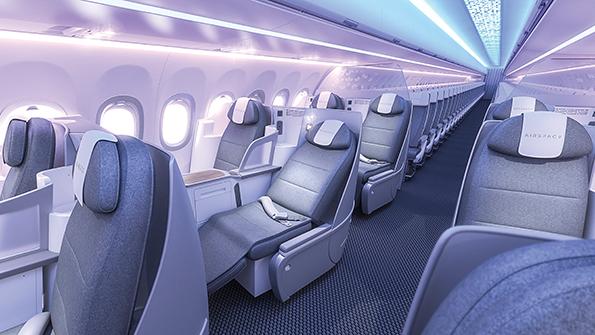
The impact of new aircraft technologies, particularly on long-haul premium, has become a major discussion point as airlines seek to blend the narrowbody and widebody cabin experiences.
“An important trend we see today is an increasing cabin segmentation and the introduction of full-flat business-class cabins in our single-aisle aircraft,” Airbus aircraft interiors marketing director Florent Petteni told ATW.
With the emergence of longer-haul narrowbodies, like the Airbus A321LR and A321XLR, Petteni said airlines are looking to create a consistent customer experience with their widebodies.
“Airlines require equivalent levels of comfort, as well as a consistent cabin branding, compared to what they are flying today in their widebodies, especially for their business-class passengers. We are working with different seat suppliers to have a wide choice of business-class products that we can install on the A321LR and A321XLR,” he said.
Airbus responded to this shift by extending its Airspace cabin—originally designed for the A330neo and A350—to the A320 family.
Recaro Aircraft Seating CEO Mark Hiller also predicts that longer-range aircraft will put pressure on economy-seat comfort.
“Due to new fuel-efficient aircraft, nonstop flights are getting longer, and can last anywhere between seven and 18 hours,” he said. In response, Recaro has been working on product improvements, such as postural changes that give passengers more even weight distribution.
Turning to business class, Hiller said airlines are demanding greater choice, with a focus on privacy and flexible work-sleep spaces.
“Business-class cabins have improved significantly in recent years,” Hiller said. “What we are seeing is an expanded business class, which offers space for more configurations and opportunities to elevate the business-cabin experience.”
Hiller also sees lightweight design as “a significant trend that will continue to grow,” as airlines come under increasing pressure to manage their environmental footprint and their operating costs. “It’s more important than ever and we are looking for ways to further minimize the weight and spare parts needed for our seats,” he said.
Densification
For the same reason, Gary Weissel, managing officer at aircraft-cabin specialist Tronos Aviation Consulting, sees lighter-weight seats and densification as a trend that has also started to become relevant in widebody economy and business cabins.
Densification has been a narrowbody focal point for several years, but Weissel believes there is little scope to push these ultra-lightweight economy seats any further.
“Just from an engineering perspective, we’re eking out the very last amount of weight that we can get out of the seat before there has to be a significant step change in the design approach in economy-class seating. How much more blood can you squeeze out of a dry rock? I think we’re there,” he said.
Conversely, long-haul economy seats have been left reasonably untouched because they tend to have higher specifications and more options. Weissel said greater take-up of bring your own device (BYOD) IFE means some manufacturers are now turning their attention to widebody-seat space and weight efficiency.
“I am aware of a couple of seat suppliers that are working on lightweight seats on widebodies as well. We’ve really seen it more on narrowbodies, up to today. I think we’re starting to see densification come into widebodies,” he said.
This shift is not isolated to the widebody economy cabin; business-class seats are also coming under scrutiny.
“Densification is big,” he said. “When you talk about larger [long-haul] business-class cabins, our perspective is that it’s larger by seat count, not so much by footprint on the aircraft. The vast majority of new business-class innovation is around getting more seats into the same, or a smaller, footprint, while still giving passengers similar—or sometimes even more—space than the previous generation. That seems counterintuitive, but it’s the evolution of good industrial design, making the most of the space you have available.”
Alongside densification, Weissel said that all-aisle access is the “gold standard” that many airlines are looking for in long-haul business class.
“That’s the next evolution that we’re seeing. With the MAXs and neos now going beyond regional flights, we’re also beginning to see more interest in high-density lie-flat seats in narrowbodies.”
Airlines have to make tough decisions over whether all-aisle access will lead to greater market share and higher load factors. When forced to choose between offering a better product or greater seat numbers, Weissel said higher revenue will usually win out.
“It all goes back to the financials. How much more density can I get, if I don’t give every seat aisle access? Business class is the cash cow for most airlines, with the highest margins, so often they will make a decision for a product that has a higher density, versus a product that gives every seat aisle access. The goal for seat suppliers and designers is to come up with new configurations, with improved density, where you still give every passenger aisle access.”
Privacy
Weissel is also seeing a ripple effect through the widebody cabin, as first class evolves from pod seats to a private-jet style experience. Doors to provide privacy are becoming more commonplace in business class, while premium economy is evolving to include larger, more complex seats with greater functionality. “It’s now getting closer and closer to what business class was maybe 15 years ago,” he observed.
The quest for lightweight materials with reduced manufacturing costs will always be a focus, Weissel said, particularly with airlines coming under greater environmental scrutiny. However, economics will continue to be the driving force.
“I think in the end, being green is still more driven by financial levers than it is by social levers. When being green has a financial benefit, that’s when you’ll really see the shift over in the interiors supply chain,” Weissel said.
“If I’m green [as an airline], other than a good press release, what’s my return on investment? Is the seat cheaper to me? Is the seat cheaper to maintain? Is it cheaper to buy? Is it lighter weight, so I’m going to burn less fuel? If the answer to all those things is ‘no,’ or ‘we don’t know,’ it’s a really tough sell.”
Health monitoring
Other cabin elements that are attracting continued attention include seat-back USB and mains power (to support the BYOD trend), LED/mood lighting and narrowbody overhead bin upgrades.
Intelligent seat-health monitoring is another trend, with Recaro’s connected iSeat already in service on TAP Air Portugal’s A321s. The iSeat’s sensors gather data on seat performance and generic behavior during flight, which can be analyzed to track passenger preferences and enable predictive maintenance.
However, Weissel believes it is still early days for this technology. “I think health monitoring is still a way off. It gets good press, but I don’t see airlines being willing to pay for it,” he said. “We haven’t really seen a big change there yet—it’s been talked about for a long time—but I don’t know that there’s been a step change beyond what has been going on for a number of years, which is monitoring of the actuation systems on fully electric seats.”
GDC Technics aviation strategy VP Cristian Sutter is an aircraft cabin designer. “The trends for addressing passenger well-being—and opportunities for socializing and changing scenarios within the flight—are high on the agenda,” he said.
Like Sutter, Safran is witnessing greater demand for creative social spaces onboard, such as hybrid galley/self-serve bar units and lounge areas.
“Our users expect the environment in the cabin to mirror life off the plane in ways big and small, and our products are constantly evolving as a result,” Safran VP-marketing Nathan Kwok said.
This is feeding into galley design, creating a more “modern kitchen” feel, closer to the home experience.
Kwok also sees scope for wider use of smart technologies, drawing data from a network of sensors across the cabin.
“One example is our smart trolley technology called Sophy, which ensures that meal carts are never lost or mixed up, helping to improve efficiency,” he said.
Like others, Kwok sees a focus on giving first- and business-class travelers “a very premium experience,” which links back to the theme of cross-fleet consistency. “We are seeing demand for two- and even three-class configurations on regional aircraft. In response we offer retrofit packages on both E-Jet and CRJ aircraft, with larger bins and larger lavatories, so a passenger who just got off a long-haul flight in business class can continue to bring their carry-on into their connecting aircraft.”
“Greater varieties of service and choice continue to be a major driver,” Kwok said.
